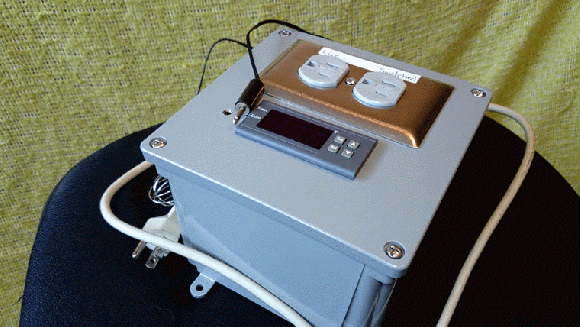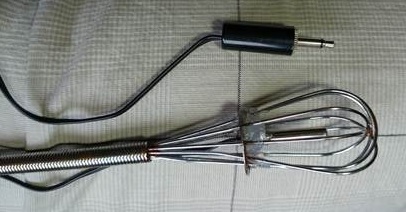
If you have not heard of the sous-vide method of cooking you are not alone. This method uses a low temperature water bath to cook food in airtight plastic bags. Because the temperatures are much lower than normal the cooking time must be much longer and the actual temperature is very critical. The advantage is that the food is heated evenly without overcooking the outside. Since the food is bagged, it also retains moisture.
[Brian] put together a sous-vide control system to automatically maintain the correct temperature of a rice cooker. A temperature control unit was sourced on eBay for about $15. This is not a bad deal considering it has an LED display, control buttons, built-in relay and thermometer input. The control unit is mounted inside a project box with a few other components. The 120 volt AC line comes into the box where the neutral and ground are connected to the control unit and a standard outlet. The hot wire is connected directly to the control unit which determines if the hot wire is or isn’t connected to the outlet by using its built-in relay.

A 3.5 mm headphone jack is also mounted into the project box to make it possible to connect the thermometer. Check out how [Brain] prevents the thermometer from contacting the rice cooker, he mounted it inside a whisk. Keeping the thermometer away from the rice cooker inner surface ensures an accurate temperature reading of the water, not the heating element. Based on the signal received from the thermometer, the control unit determines whether or not to turn on the rice cooker.
Because this project uses a standard outlet as its interface to the cooker, it could be used for anything that is dependent on the ambient temperature. It could turn on an AC unit if it’s too hot or control your 3D Printer’s heated build enclosure.














The temperature controller there looks to be an STC-1000. They’re great little devices. They can toggle both heating and cooling circuits, and have adjustable hysteresis and a timer to keep from cycling a refrigeration compressor too quickly. Incidentally, they also allow manual calibration adjustment… and if you’re going to intercalate a jack and plug, you should definitely do that, as they could throw off the thermistor reading. (Personally, though, I’d be worried that condensation or tarnishing of the connectors could cause the readings to drift over time.)
I’d suggest using monster cables for your connections. Studies show that steaks tasted 23% better when cooked with monster cables than with regular 3.5mm stereo jacks.
Pfft, Monster is crap. You need something that can truly compensate for low level meat-jitter. Active meat transmission or bust.
PEAR cables are the way to go, if you can afford $40,000. More expensive means better!
Nickel plated plugs like that shouldn’t tarnish.
Built one of these like 2 years ago, right down to the wire whisk temperature probe cage. I used an aquarium pump with a “T” in the line to create a water circulator.
Mine started out with the STC-1000, but it burnt out after like 3 months. I swapped it out for a D1S-VR-220 and a 50A SSR. It’s been going strong ever since, and maintains the temp inside of 1C after an initial autotune.
Note: For a rice cooker or a crock pot, a water circulator is unnecessary, but I am using mine with a 22qt roaster.
This looks to be thermostatic and not pid control. I struggled to get my sous vide accurate within 1 degree kelvin with thermostatic but managed about .3 degrees kelvin with pid (after tuning). The most important thing for me was precision, I had to get a 12 bit thermometer/adc before I could get decent accuracy (DS18B20).
Totally not on the topic… but.. what exactly is a _degree_ Kelvin?
Kelvin is the scientific standard for measuring temperature. 1 degree Kelvin is equivalent to 1 degree Celsius, but is read with a different number. The conversion to C to K is C minus 273.15.
Whoosh.
@Dalton: While your answer is clearly trying to be helpful, I think Brian wasn’t being particularly nice, and was trying to point out that, since kelvin is an absolute temperature scale (0 kelvin = absolute zero), it is not correct to refer to it as “a degree kelvin”, but rather just “a kelvin”.
http://en.wikipedia.org/wiki/Kelvin
Not completely true, Kelvin is often used to describe temperature differential.
No, not really. It was arbitrarily changed in ’67 for no rational reason. Not unlike the forced change of Aluminum to Aluminium for it to sound more scientific (Discoverers get naming rights. Doesn’t matter if a scientific society decides to change it to fit their liking later). It is still a portion of a scale. Thus a degree. There is no absolute temperature numbers as there is no absolute way to measure anything except in whole. Thus the difference between rational and whole numbers. All units of measurement are as valid as the next, but may not be very convenient.
Actually, the original discoverer of Aluminium went from Alumium to Aluminum to Aluminium within a few years. But the dictionary kept the word ‘Aluminum’, so that’s what Americans stuck with. The rest of the western world has always called it Aluminium.
Like the metric system or civil rights, the US is the slow child in the classroom. ;-)
Brian is referring to the convention that kelvin is itself a unit, not a scale. So you say 237 Kelvin, not 237 degrees Kelvin. It’s like saying degrees meter or degrees liter.
My bad. Now I know the degree of my error I decree it absolutely won’t leave me feeling cold, or get me hot under the collar. I’ll be as cool as a newt on a lily pad. My ignorance will go to absolute zero.
@David: That was amazing. Truly :)
Nice GIF
Saying sous vide cooking is simply “cooking at low temperatures” is a bit too simplified. It’s not cooking at low temperatures, it’s cooking at the _correct_ temperature for a certain effect to occur. Classical cooking uses boiling water because it is the easiest way to have water a known temperature (Exactly 100 degrees C). But in reality, what we are after are changes on the molecular level that occur at specific temperatures.
So for example egg-white is done at around 70, while the yolk (depending on your taste) must be somewhere between 64 and 80 degrees C. Dunking an egg in boiling water for 4 minutes is simply a crude way to achieve this.
Similarly, steak reaches its different levels of done-ness at specific temperatures. Steak restaurants will often use sous-vide to get a stead at the desired level through and through, then shortly fry it to caramelize the outside (which happens around 180 degrees C).
“Since the food is bagged, it also retains moisture”
The bag will retain the moisture, but the food might not, depending on what’s cooking.
It is possible, for example, to end up with a very dry piece of meat floating in its own juices, especially at the higher temp ranges.
Exactly the same as mine…. http://thearduinoguy.blogspot.co.uk/2013/10/SousVideCooker.html
I’m curious about the choice of an expensive waterproof box and cable gland combined with a very non-waterproof outlet on the top.
I recently built essentially the same thing, but for use as a keezer temperature controller.
That particular box is convenient because the STC-1000 is relatively deep, and it can accommodate the STC-1000 and an outlet. It wasn’t particularly expensive – was ~$8 at the local big-box home store.
It’s also probably popular because it’s the one used in http://makezine.com/projects/water-bath-thermostat/ , which many of these projects seem to be based off of. (I sure know mine was!)
Cable glands also happen to be convenient as bombproof strain relievers.
This reminds me of mine!
Sorry for the crummy pic quality: http://i.imgur.com/ZQ3kulz.jpg
I’ve used both a deep fryer and a large crock pot as a vessel. I love the temperature probe in the whisk idea. Right now i just have mine threaded in the hole in the glass where the handle screwed on the lid.